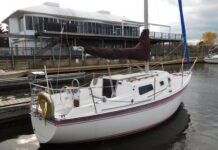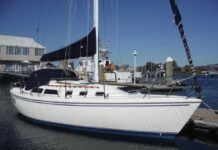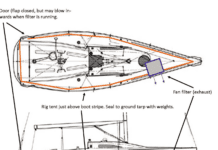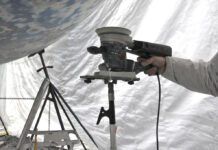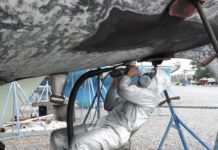In last month’s issue we reviewed three four-horsepower four-stroke engines (which really amounted to six engines in all, since a couple of the same engines are sold under different names). We continue our outboard evaluations this month with a close look at four eight-horse four-strokes.
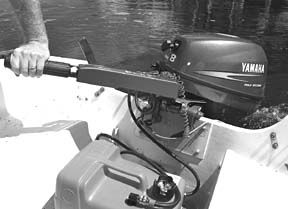
What We Tested
We tested this group of powerplants off Key Largo, FL. St. Petersburg-based Marlin Marine supplied a Honda, while Cannons Marina on Longboat Key let us borrow a Yamaha. Canadian conglomerate Bombardier shipped us its Johnson 8 via one of its Florida Keys Johnson dealers, Sandy Cove Marine. Rounding out our quartet was the newly designed Tohatsu 8. The manufacturer shipped it directly to us and told us that we were the first magazine to test this engine.
How We Tested
Following the same procedures established during our 4-hp run-off, with a couple of necessary exceptions, PS put this group through the same series of tests and ratings. Instead of using our 10-foot Apex inflatable—which proved incapable of handling the weight of some of the test engines—we moved to a larger, sturdier test boat. (Testers did use the inflatable to break in some of the engines, but not for testing.)
Our new test boat, named Mustard Seed, is not new at all—it’s actually a small retired daysailer that’s been demasted and stripped of most of its weight. With a hull speed of less than six knots, we didn’t even try any speed testing.
To save what was left of our editors’ well-worn backs, we carted the engines around as much as possible using a Garelick two-wheel aluminum engine stand.
The first thing we did with each engine was place it on the stand for an initial inspection. The crankcase was filled with engine oil, and we shot a quick photo. Then we tied Mustard Seed next to a Contender powerboat (making it easier to step to the low-sided sailboat) and manhandled the engines from one to the other.
After tightening the transom clamps and connecting an external fuel tank, we started each engine—the start rating was based on numerous start attempts throughout the day. We gave each an installation rating based on how easy or difficult it was to put the engine on and off the transom.
With the engine started and running, the testers spent the next couple of hours breaking it in. All were right out of the box and needed at least two hours of running prior to wide-open throttle operation. We used protected water to test and rate each engine for operation and noise at idle. Testers also checked each to make sure that shifting to reverse and jamming full throttle would not jump the lower unit out of the water. Once in the ocean, we evaluated each for performance and noise at wide-open throttle (WOT) and rated tilting and lowering. Back at the dock, we had our crew remove the engine and place it on the dock for side-storage evaluation. Then it was back on the stand for more photos and a thorough inspection. We then drained the crankcase oil, flushed the engines with fresh water and gave them a quick wash.
As with the 4-hp engine test, we collected no speed or fuel flow data, figuring neither is a major issue in this horsepower class.
What We Found
Here are items and qualities we found common to all four engines: All have oil drains located below the powerhead on the side of the case—excellent locations, making oil removal easy. All four engines have a tendency to vibrate at power settings slightly above idle. The Johnson vibrated the most, in our estimation. Three of the engines come standard with a plastic gas tank and associated fuel lines, bulbs, and hardware. Tanks average just over 3 gallons in capacity. Yamaha does not ship its engine with a tank.
None in this group should be considered portable. They are all quite heavy and unwieldy—it’s a chore to load one on and off the transom of a boat floating next to a dock or tied alongside.
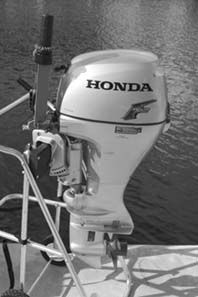
Honda 8
Honda has a pair of 8-hp four strokes on the market, the older square-hood classic 8 and the newer more stylish BF8. The classic weighs in at a svelte 77 pounds. The BF version, the one we tested, tips the scales at a hefty 92 pounds.
The BF8 is actually a de-rated 9.9-hp motor. Problems arise when engine builders try to cover more than one horsepower bracket with the same basic engine block. The engine usually only fits well into one horsepower class. That’s the case here. As a 9.9, this engine is light compared to the competition, but as an 8 it’s quite overweight and very bulky, in our view. These qualities garnered it a Poor rating for both portability and installation.
Like all the other engines, the Honda starts easily. Performance was good right from the start of break-in throughout the two days of testing. We rated it Excellent on starting and idle operation. Noise levels were within one decibel of the lowest, measuring 59 at idle and 85 at WOT.
Both the shifter and tiller are hinged on the front-side of the Honda with the tiller extending nearly 18″ off the transom. The tiller has a nice feel to it, with a rubberized throttle grip and a top-quality throttle friction lock. The kill switch is located close to the throttle as well. The shifter, located on the centerline of the engine, was wobbly and did not operate as smoothly or easily as the others.
A lever between the transom bracket and the bottom of the engine controls steering tension on the Honda. It works well, and we like the lever style system on this engine and the Yamaha. The Honda’s steering tension even at maximum will not lock the engine in position. We wish it did. It makes starting and tilting the engine much easier.
We rated tilting Good on the Honda: To tilt, flip the tilt lever toward the operator then lift using the tiller handle as an assist. To lower the engine, flip the lever up and aft, then pull the engine toward you to fully unlock. Now you’re free to lower the engine.
A single latch at the rear of the motor releases the hood for easy removal and yields access to user-serviceable items. To add oil, you’ll need to find the yellow oil fill cap located on the starboard side aft area of the engine—it’s easy to see. Not so easy to see is the oil dipstick, which is located on the same side but farther forward, and colored black.
To fully comply with the manufacturer’s instructions, an oil filter change is required every other oil change. This necessitates removal of the engine’s lower right-hand side panel, and is the reason for our Poor rating on oil filter access.
Like all the small four-strokes we’ve tested so far, the Honda can be stored in only two positions, either vertically or laid down on one side. The side designated for storage is usually marked, and on the Honda a pair of starboard side rests identify the proper side for storage. When laid on its side, the engine is stable on its two rests and its propeller. It has a front carry handle on the transom bracket between the two clamps and a case indentation at the rear—but it’s a bear to lift.
One feature found only on the Honda is a 6-ampere, 12-volt generator.
Bottom Line: By far the biggest and heaviest engine tested, we think the BF8 would be best used in a more-or-less permanent mounting on the transom of a good-sized trailer-sailer or multihull, not as a powerplant for your inflatable, if you contemplate having to shift the engine on and off several times during the season.
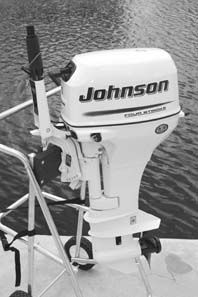
Johnson 8
At 83 pounds, Bombardier’s Johnson-branded 8 is the second-lightest engine tested. The Chinese-built engine started and performed well during all testing, earning an Excellent in its category.
The tiller design on the Johnson needs to be improved, in our opinion. The tiller is short, reaching only 12″ off the transom, and instead of a friction lock it has an idle adjustment knob. We think a throttle friction lock is a valuable feature.
The shifter is mounted on the front of the engine, nearly on centerline, and appears sturdy. It worked nicely too, having well-defined detents and smooth action. Tilting is similar to the Honda, with a lever to lock and unlock. We rated it Good.
Another similarity with the Honda is the front carrying handle. They’re nearly identical, though this engine is easier to tote around because it’s somewhat smaller and lighter.
Steering tension on the Johnson is adjusted via a standard screw head on the port side just below the powerhead, which put it slightly above the waterline when installed on the Mustard Seed. It will lock in any position when tightened to its maximum, but it’s not as easily accessed as the front-mounted levers on the Yamaha and Honda.
The cover on the Johnson fit poorly and came loose when we used it as a handhold for tilting. Its hold-down latch was also difficult to operate.
The Johnson registered 62 decibels at idle and 88.5 at WOT. With the cowling off, the oil fill and dipstick can be identified readily, as both are located mid-block and colored yellow. Operator’s guide instructions recommend cleaning the oil screen on every oil change. This requires removal of a case screw on the back of the engine. The filter itself is in a difficult location to reach—we rated oil filter access Poor.
The Johnson owner’s manual lists instructions for side storage: “Raise the tiller handle and rest it on a padded surface on its port side.” A drawing shows the engine with the powerhead slightly elevated to prevent residual water from entering the cylinder and causing damage. As with all these engines, another option is vertical storage on a stand or on the boat.
Bottom Line: This engine is not up to the standards demonstrated by the other engines in our test, in our opinion. It has an ill-fitting cowl, short tiller, no throttle friction lock, and a hard-to-reach oil filter.
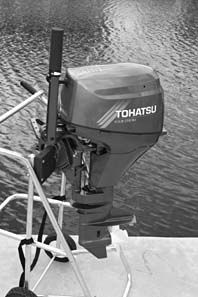
Tohatsu 8
One-pull starting was the norm with the Tohatsu during our on-the-water testing. After the break-in, it operated smoothly at all power settings from idle to WOT. However, it did stall a couple of times during early break-in runs, causing us to suspect that its idle speed might be set a tad low.
Tohatsu America spokeswoman Jennifer Pharris addressed the stalling issue with these comments: “When a dealer does a pre-delivery inspection, they make sure that the idle is set properly. This is how the customer will get the engine 99% of the time… That is part of what the dealer does for the customer.”
Shifting is accomplished with a starboard-side lever located on the forward portion of the case. Compared to the tiller-mounted shifter on the Yamaha, this one is a much longer reach away. Once you get a hand on the shifter, it does operate smoothly and easily. We’d prefer it to be mounted on the front of the engine, or on the tiller. The tiller handle extends a full 19″ off the transom, second in length to the Yamaha.
Steering tension on the Tohatsu is adjusted via a portside hex-head bolt located on the engine’s center shaft just above the waterline. A small toolkit supplied with the engine contains the appropriate wrench—and we’d advise carrying it. We think the lever-controlled steering tension on the Honda and Yamaha is a better method of adjustment, especially since it requires no tools. The steering tension adjustment on the Tohatsu will lock the engine in position when tightened to its maximum, and is an effective aid for starting, lifting, and lowering.
Pushing the starboard-side tilt lever releases the engine for lifting; however, while you’re holding the engine up with one hand, you’ll need to grope blindly for the tilt lever with your other hand and flip it to lock the engine in the up position. It’s awkward, and is the reason for the Fair rating.
Lowering the engine is easier: Just pull it up a little farther and it automatically unlocks and is free to lower.
The Tohatsu was the quietest of the group, registering only 58 decibels from 3 feet away at idle and 85 decibels at WOT. In addition to its quiet operation, the Tohatsu is also the lightest of the engines tested. A large front carry handle and case indentation at the back provide handholds for lifting.
Simply unclip its single rear snap to remove the Tohatsu’s cowling. The oil fill is at the back of the engine, making it more difficult to add oil while the engine is mounted on a boat. With the boat on a trailer or the engine on a stand, oil can be added much more easily.
This engine does not have a user- serviceable oil filter. To check the oil, it’s best to turn the engine hard to starboard—the dipstick is located about mid-block behind and below the carburetor. Spark plugs are easy to reach on the starboard side of the block.
The owner’s manual recommends storing the engine in the vertical position. A drawing of side storage is also shown, and the case does have side storage bumps. When laid handle-side down, it’s stable on the bumps, tiller handle, and prop.
Bottom Line: It’s the lightest, quietest, and least expensive of the four engines tested. Not as refined as the Yamaha, but if your budget gets top priority, this is the one for you.
Yamaha 8
Yamaha has two versions of its 8-hp four-stroke, the standard version known as the F8 and the high-thrust model, the T8. We tested the F8 and all of our comments regarding weight, portability, and ease of installation apply only to the F8. The T8 has a beefier transom bracket, a high gear ratio lower unit, and is available only in 20- or 25-inch shaft lengths. These features add significantly to the cost, weight, and bulk of the engine.
We rated the F8 Excellent in starting and idle operation, and liked its performance throughout break-in and testing. It is, however, the loudest of the group, registering 65 decibels at idle and 89 decibels at WOT.
Engineering of the tiller is impressive, with features not found on any of the other engines. The tiller extends more than 22″ from the transom, and the shifter is mounted directly behind the standard throttle grip and friction lock. Just behind the shifter is the kill switch. All controls are within a short reach and operate smoothly. This arrangement is intelligent and very convenient.
A lever similar to the one on the Honda, but more refined, adjusts steering tension on the F8. With the lever set to the minimum tension position, steering is a little stiffer than we’d like, and the lever blocks the carry handle. This serves as a physical reminder, at least when we ran the engine, to tighten the lever and lock the engine in position prior to lifting. It’s obvious that Yamaha put some serious thought into this system.
The control cable running to the tiller slightly obstructs access to the front carry handle. This handle and a rear case indentation provide handholds for lifting.
Tilting is another highly refined feature on the Yamaha. The tilt lever is located on the front of the engine just below the steering tension lever and carry handle. The lever is flipped in one direction to raise the engine and the other to lower.
A trick we found worked well on the Yamaha was pushing down on the tiller handle to help start tilting. Once it’s on the way up, you can grab the rear of the engine and finish the job. The lever and mechanics of the tilt system work very well and we rated it Excellent, the only one in the test group to get that rating in this category.
One rear latch holds the cowling down on the F8. It operated easily and the hood fit well. Under the hood we rated oil fill, dipstick, and spark plug access all Fair. There is no user-serviceable oil filter. The Yamaha has a freshwater flushing adapter on the starboard side.
Storage positions acceptable on the Yamaha are vertical or horizontal on the tiller side. Unlike all the other engines, the F8 is not shipped with a fuel tank.
Bottom Line: Yamaha’s F8 is about $100 more (street price) than the Honda and Johnson, but we think its superior features and tiller-mounted shifter make it worth the extra cash.
Conclusions
Yamaha’s engineers have put a lot of thought and design effort into the redesign of several of their small four-stroke outboards, and the F8 has benefited immensely from this effort. We must rate Yamaha’s F8 as the cream of this crop. Its long tiller, and tiller-mounted shifter, superbly engineered steering tension, and tilting mechanisms are just some of its high points.
On the downside, the Yamaha was the loudest 8-hp we tested by several decibels, and it is the most expensive of the group by about $100. However, we wouldn’t let these points stop us from buying this engine. It’s just too good in every other respect.
The Tohatsu 8 is still such a new engine that street prices haven’t stabilized yet. We’ve only found one so far, and it marks the engine as the least expensive 8-hp four-stroke on the market, just as we suspected it would be, given its lower MSRP. With that in mind, the Tohatsu is our second choice. It certainly has some faults, but it’s light, quiet, and the least expensive of this foursome.
If you’re considering the replacement of an 8-hp two-stroke engine with a four-stroke, be alert to the weight issue—a new four-stroke may simply be too heavy to work in the same place, whether on your sailboat or dinghy transom. It will also be more expensive. Compare, for example, a new Tohatsu 8-hp two-stroke, which weighs about 60 lbs. and can be had for around $1,200.
If you can manage it, go with a four-stroke. Two-strokes are smoky, dirty polluters. And let’s hope four-stroke engines get lighter and cheaper, sooner rather than later.
Also With This Article
Click here to view “Capacity Plate Myths.”
Click here to view “Value Guide: 8-HP 4-Strokes.”
Click here to view “Ratings: 8-HP 4-Strokes.”
Contacts
• Honda, 770/497-6400, www.honda-marine.com
• Johnson, 847/689-7090, www.johnson.com
• Tohatsu, 972/323-6003, www.tohatsu.com
• Yamaha, 800/962-7926, www.yamaha-motor.com


